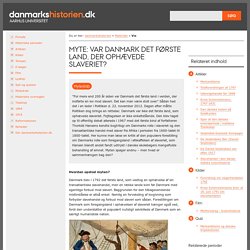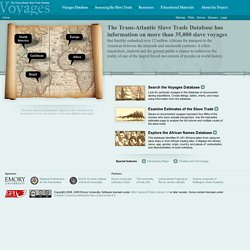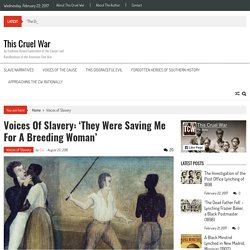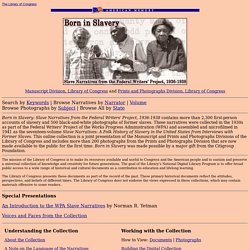

MYTE: Var Danmark det første land, der ophævede slaveriet? Mytedrab ”For mere end 200 år siden var Danmark det første land i verden, der indførte en lov mod slaveri.

Det kan man være stolt over.” Sådan hed det i en leder i Politiken d. 22. november 2012. Dagen efter måtte Politiken dog bringe en rettelse: Danmark var ikke det første land, som ophævede slaveriet. Fejltagelsen er ikke enkeltstående. Hvordan opstod myten? Danmark blev i 1792 det første land, som vedtog en ophævelse af sin transatlantiske slavehandel, men en række lande kom før Danmark med egentlige forbud mod slaveri. Slavehandlen var til hidsig debat i England, da Danmark vedtog forbuddet mod den transatlantiske slavehandel. Det danske forbud mod transatlantisk slavehandel Med ”Forordning om negerhandlen” i 1792 blev Danmark det første land i verden, som vedtog en lov til ophævelse af sin transatlantiske handel med slaver.
Store økonomiske interesser i slaveriet Ernst Schimmelmann: Initiativtager til ”Forordning om negerhandlen” i 1792 – og Danmarks største slaveejer. Trans-Atlantic Slave Trade. Roll over names of designated regions on the map above for descriptions of the role of each in the trans-Atlantic slave trade.

The North American mainland played a relatively minor role in the trans-Atlantic slave trade. Its ports sent out less than five percent of all known voyages, and its slave markets absorbed less than four percent of all slaves carried off from Africa. An intra-American trade in slaves – originating in the Caribbean - supplied additional slaves, however. This region was exceptional in the Americas in that a positive rate of natural population growth began relatively early, thus reducing the dependence of the region on coerced migrants. Slavery · George Washington's Mount Vernon. Voices of Slavery: 'They Were Saving Me For a Breeding Woman' - This Cruel War. During 1929 and 1930, an Africa-American scholar named Ophelia Settle Egypt, conducted nearly 100 interviews with former slaves.

Working then at Fisk University, she was the first person to ever conduct such a large scale endeavor. Accompanied by Charles Johnson, a black sociologist, she was able to get the former slaves to open up about the waning days of the institution. In 1945, she finally published her Unwritten History of Slavery, which collected thirty-eight transcripts of the interviews. Each account, published anonymously, painted a fuller picture of black slavery in Tennessee and Kentucky, where most of the interviewees had resided. This first account, entitled “One of Dr. Just the other day we were talking about white people when they had slaves. Related Slave Narratives, Imposed Dialect and the N-Bomb One of the regular segments on This Cruel War is the "Voices of Slavery" series in which I share slave narratives.
March 15, 2016. Born in Slavery: Slave Narratives from the Federal Writers' Project, 1936-1938. The Library of Congress Manuscript Division, Library of Congress and Prints and Photographs Division, Library of Congress Search by Keywords | Browse Narratives by Narrator | VolumeBrowse Photographs by Subject | Browse All by State Born in Slavery: Slave Narratives from the Federal Writers' Project, 1936-1938 contains more than 2,300 first-person accounts of slavery and 500 black-and-white photographs of former slaves.

These narratives were collected in the 1930s as part of the Federal Writers' Project of the Works Progress Administration (WPA) and assembled and microfilmed in 1941 as the seventeen-volume Slave Narratives: A Folk History of Slavery in the United States from Interviews with Former Slaves. This online collection is a joint presentation of the Manuscript and Prints and Photographs Divisions of the Library of Congress and includes more than 200 photographs from the Prints and Photographs Division that are now made available to the public for the first time. Black Freedom Struggle in the United States: A Selection of Primary Sources. Slavery_pamphlet.pdf. Documenting the American South homepage. Abolition of slavery. American Memory from the Library of Congress - African American Hostory. Legacy of Slavery in Maryland. Historielab. Aarhus Universitetsforlag udgiver serien ”100 Danmarkshistorier”.

Bogserien består af 100 bøger á 100 sider over 8 år, hvor forskere fortæller danmarkshistoriens vigtigste begivenheder i et lettilgængeligt sprog. I tilknytning hertil udarbejder HistorieLab – Nationalt Videncenter for Historie- og Kulturarvsformidling en række undervisningsforløb, der indeholder kildesamlinger og lærervejledninger. Kildebanken om slaveriet og Vestindien består af flere end 130 kilder, der er inddelt i de 12 temaer du ser nedenfor.
I hvert tema findes der mellem 10-15 kilder, der kan hjælpe dig til at besvare dine spørgsmål og problemstillinger om slavehandelen, slavernes liv og arbejde på De Dansk Vestindiske Øer og meget mere. Klik på et af temaerne herunder og dyk ned i kildebankens kilder! Denne kildebank er tiltænkt mellemtrinnet og udskolingen. Triggere til elever 1. 2. 3. 4. 5. 6.